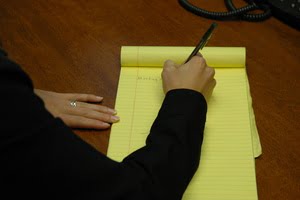With adaptive software – screen-reader and magnification programs – blind people can access computers and level the field for jobs, education, or recreation. I know, because although I am not blind, for three years, I taught blind people how to use adaptive software to access computers. Two kinds of adaptive software that give blind people access to computers are magnification and screen-reader. To understand how those kinds of adaptive software help blind people access a computer, we have to clarify that not all blind people are totally blind.
The legal definition of being blind is vision (visual acuity) of 20/200 or less with the best correction in the better eye. In other words, someone who is a legally blind has to be 20 feet from an object to see it with vision correction with the same clarity as a normally sighted person could from 200 feet. Another way of judging blindness is the width of the visual field. Normally sighted people have a field of some 180 degrees. Those with a visual field of less than twenty degrees are legally blind.
Many blind people have some degree of usable vision. I have known legally blind people who continue to drive – illegally, I might add. If blind people want to access a computer, the first step is to determine which kind of adaptive software is appropriate, screen-reader of magnifier.
For someone with no usable vision, the only option is the screen-reader, and for those with fairly usable vision, the magnification program may be better, but many visually impaired people face a difficult decision, choosing the screen-reader or magnification. This is important because screen-reader adaptive software is difficult to learn to use, but for the blind, there is no more worthwhile effort.
The best-known screen-reader is JAWS. Despite its name (an acronym for Job Access With Speech), JAWS is also a screen-reader for blind students in high school and college. To learn to use a screen-reader, I practiced it by turning off the monitor, so that I would have to learn to trust the screen-reader as blind users do when they access a computer.
Just as output from a screen-reader must be auditory, so must all input be from the keyboard, because a user of JAWS or other screen-reader cannot see where the mouse is pointing. To use JAWS or another screen-reader, blind people must learn all the standard hot keystrokes associated with Windows (which most of us do not use), but they must also learn special JAWS keystrokes to get the screen-reader program to read.
JAWS offers access to all the major Microsoft programs and to the Internet, although to access the Internet poses challenges to JAWS users. But, it also offers them access to daily newspapers, online periodicals and discussion groups, email… in fact, everything it offers anyone reading this article. (Here is a recent article on one JAWS-user’s problems with the Internet.)
There are two major magnification programs, MAGic, which is published by FreedomScientific, the company that publishes JAWS, and ZoomText, published by AI Squared. While many users of these magnification programs have an almost religious devotion to one magnification program or the other, to me they are virtually interchangeable. They provide magnification up to 36x (although at that point, the program is almost unusable, and it would be better to use a screen-reader). Besides magnification, they offer variations in color and some speech. Magnification programs also offer accessibility to all standard programs and the Internet.
Since users of magnification have some usable vision, they can use the mouse, and in fact, people who used a computer before they lost their vision can learn to access a computer with magnification very quickly.
You can download fully functional demo versions of these adaptive programs, whether you need them or not, to learn more about them:
JAWS – screen-reader
MAGic – magnification
ZoomText – magnification (you have to create a free account)
Window-Eyes – screen-reader (this demo is not free)
Big Shot (published by AI Squared, so follow the link for ZoomText to obtain a demo), allows magnification up to 2x, for people who are not blind but need a little magnification to access their computer but do not need fully adaptive software. (Aging baby boomers, take note!)
These programs are fairly expensive, but if you know a blind person who might benefit from them, check with various state offices for rehabilitation, education, and even (as in my state of Florida) blind services. The VA provides computers with adaptive software for blind veterans.
So, how do blind people use a computer? From what I experienced, they use computers very well… thanks not only to their adaptive software – screen-reader or magnification – but also to their intelligence and determination.


